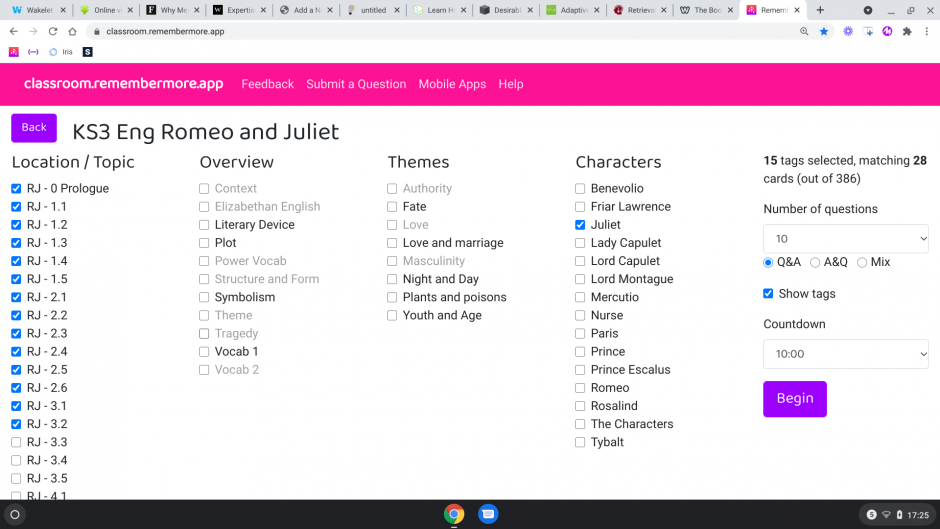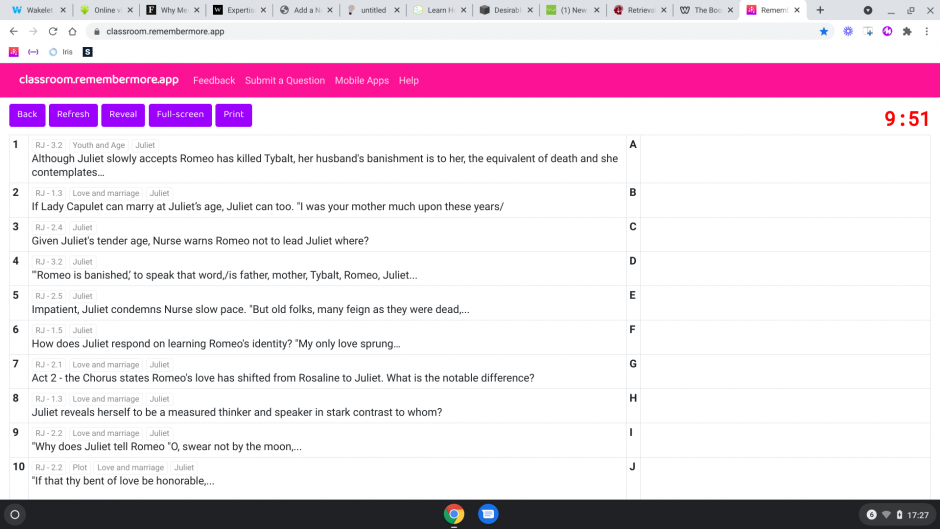This is a post I have wanted to write / share for a few week however the run into half term has been hard going… however over the past few days I have received a handful of positive endorsements, messages offers of support and welling contributions for RememberMore which has lifted my spirits.
Thank you @katmorgan, @MissDowlerDT, @andy_samm, @cmc_crea, @RK_Jonesy, @open_drama_uk, @assad_javed3, @SaysMiss, @helenpipe_1, @paigerich1970, @ChrisH367
So before the break officially kicks in… here it is. “RememberMore for remote learning” – fulfilling it’s paired aims of reducing teacher workload whilst improving student outcomes – remotely.
Part of RememberMore is classroom.remembermore.app (CRM). An open platform offering fast, flexible retrieval practice for both teachers and students.
Look out for even more content, with possible contributions for our first A Level deck, a GCSE Jekyll and Hyde deck, DT decks, KS3 English texts contributions, a brand new subject – Drama – (that is really a exciting project for collaboration and my personal curriculum knowledge development) and possibly a History collaboration. All feedback, contributions welcomed.
So – to RememberMore and remote learning (live or otherwise). When you (and your students) have access to fast, flexible content – opportunity knocks. Here are a few ways I incorporated retrieval practice and / or checking for understanding using (CRM) in my remote lessons this past fortnight.
As well as having a “Welcome” slide, I often present CRM as my live lesson intro – with early arrivals making the most of their wait time revisiting or consolidating a mix of recent and historic learning (interleaving). I used CRM to recap #plot lines, the development of the character of #Juliet to Act 3 Scene 2 and #fagin to the interval in Oliver Twist.

On two occasions I used CRM an opportunity to potentiate or prime or signpost new learning – before introducing a new scene for Romeo and Juliet. Minimal preparation, fast, flexible and adaptable.
Routines
Three routines are now quite adopted by the students – within the Q/A mode: Cold call or directed questions, “Claim a Question” and “Fast fingers.” All using the default set up, ready in less than 10s OR with defined tags. All also available to students after the lesson independently.

Directed questioning speaks for itself.
State the label: Pause for reading (to promote attention and engagement). Then “Cold call” for named student for their response.
Correct answer: Reveal – pausing for students to read. Is there an elaboration opportunity? Is it appropriate to do so? How correct was the response. Could it be enhanced? How does it connect to the tags?
Incorrect answer: Wait. Connect to tags. Pause. Open to the room. Return to the “Cold call” student to confirm / read answer.
Displaying the deserved response for all. Again, to elaborate or not?
Options: Increase difficulty by removing tags or increasing the content coverage. All Modes.
Fast fingers
State the labelled.
I tend to add FF – to prompt the chat. Sometimes I ask for a confirming code in the chat. eg R – ready.
State the label and verbally read the question or not. Students respond as fast as possible in the chat, scoring 5 points for the fastest correct answer, 4 points for second, 3 points for third, 2 points for fourth and 1 if correct – encouraging all answers.
- Students have started to add ? to show they do not know.
- Do you allow abbreviations? J = Juliet.
- Do you discount SpaG entries?
- Call for running totals. Student self report their running totals in the chat.
- Displaying the deserved response for all. Again, to elaborate or not?
Options: Increase difficulty by removing tags. All Modes.
Claim a question is a group activity where the class “claim a question” by claiming the label and answering it correctly in the chat.
As the correct answer is received, confirming the claim by revealing it on screen. That routine seems to add a little “Va va voom” to the activity. Rounds can be over very fast and we can cover two or three rounds in just a few minutes.
- Do you allow abbreviations? Discount SpaG entries?
- Call for totals at the end. Scores of three are often enough to tie for the win or win. Four almost always win.
- Student self report their running totals in the chat.
Additional helpful use cases
Focused student: Catch-up a tag task for a missed a lesson or to address a misconception.
Break out: Paired questioning between learners using the decks and tags.
Class: Preparation for, or recap of learning – during which you can target or support key learners.
Options: Increase difficulty by removing tags or increasing the content coverage. All Modes
Thank you for your support one and all.
More ideas wanted…


